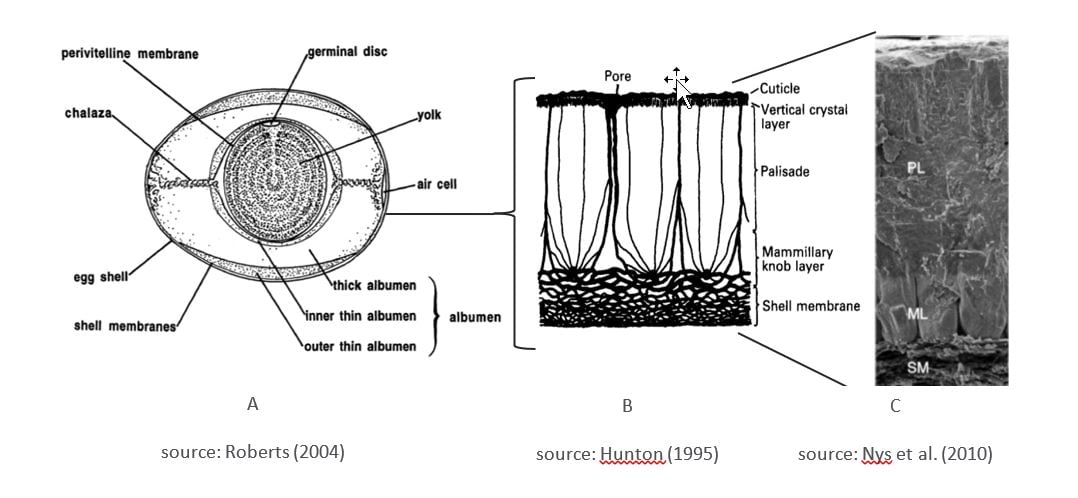The goal of layer farmers is to produce as many good quality eggs as possible and for breeder farmers to produce as many good quality fertile eggs as possible. The question is: how are you going to achieve this?
First, the egg production has to be optimal. Hens are genetically selected for producing eggs, but the environment has a large influence. This already starts before the production phase, the rearing of the hens is a crucial foundation for the later life (Hartini et al., 2002). When the hens experience repeated or chronic stress in the rearing phase, the onset of egg laying will be later and the egg production rate lower (Shini et al., 2009).
The birds also have to be healthy, get the correct feed and have to be managed properly to reach their genetic potential. When the birds go to the production phase, the light schedule is the deciding factor for when the hens mature and start producing eggs (Harrison, 1972). It is a cooperation between farmer and chicken. Without good management or without good quality chickens you cannot achieve your goal.
Second, when the hen has laid an egg, this has to be kept in optimal condition. Depending on the sector, there are different requirements for the producer. For both consumption and hatching eggs, we want intact shells and clean eggs. Otherwise the eggs are not sellable as a first class egg, which means less money per egg and a waste of resources. First grade eggs are safe for consumption or suitable for hatching a chick.
For consumption eggs, yolk colour can also be important. Yolk colour has nothing to do with the quality of the egg, but with consumers’ preference. Both the feed and housing system can have an effect on yolk colour (Rakonjac et al., 2014). For hatching eggs, fertilisation is an extra requirement, since this is the only way to produce chicks.
Egg formation
As we know, an egg is the product of a hen for reproduction, a protected space for the chick to develop in. For optimal development, the egg needs to be of good quality. While the egg moves through the reproductive tract, the egg is built up. First the egg white is formed around the yolk, then the membranes are formed around the egg white and lastly the shell is created (Sturkie and Mueller, 1976).
An egg consists of 60% albumen, 30% yolk and 10% egg shell (Rakonjac et al., 2014). Albumen has an important role during embryonic development, since it forms sub embryonic fluid and it is the main source of protein. The yolk is spare food for the developing chick and the egg shell protects the contents. This whole formation process takes 25 hours. At the end of the oviduct, the egg makes a turn, so the egg is laid with the biggest part first. When the egg is turned the colon closes, to make more space for the egg and prevent that the egg becomes dirty. Then the egg will be transferred from inside the hen to the outside.
Sometimes the formation of an egg goes wrong inside the hen. Diseases, unbalanced feed or stressful conditions can all be the cause of abnormal eggs. 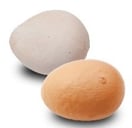 Abnormal eggs can be misshaped or have a deviating egg shell (Figure 1). Misshaped eggs are not accepted by consumers and cause issues for chick development (Narushin & Romanov, 2002). Deviating egg shells are usually less strong and are thus removed from further processing to avoid broken eggs (Yan et al., 2013).
Abnormal eggs can be misshaped or have a deviating egg shell (Figure 1). Misshaped eggs are not accepted by consumers and cause issues for chick development (Narushin & Romanov, 2002). Deviating egg shells are usually less strong and are thus removed from further processing to avoid broken eggs (Yan et al., 2013).
When you see an increase of abnormal eggs, you should investigate if something is wrong in the house. This can be a signal that for example the health of 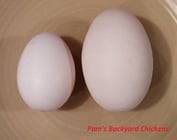 the hens is under pressure. Double yolked eggs are another example of a wrongly formed egg (Figure 2), which are unsuitable for hatching a chick (Salamon, 2020). For consumption eggs, it depends on the market whether these eggs have extra value or are regarded as second grade eggs.
the hens is under pressure. Double yolked eggs are another example of a wrongly formed egg (Figure 2), which are unsuitable for hatching a chick (Salamon, 2020). For consumption eggs, it depends on the market whether these eggs have extra value or are regarded as second grade eggs.
Sometimes an egg has blood on it (Figure 3), which is usually 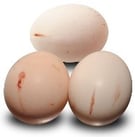 caused by stretching of the internal organs when the hen is still young. It could also be caused by small wounds of the cloaca, so when you see many eggs with blood it is important to check for pecking behaviour.
caused by stretching of the internal organs when the hen is still young. It could also be caused by small wounds of the cloaca, so when you see many eggs with blood it is important to check for pecking behaviour.
External factors affecting egg quality
So in principle the egg is perfect when it is laid, but then it is subjected to external factors that might influence the egg quality. The body temperature of a hen is about 10-20 ºC higher than the house temperature, so the eggs directly start cooling down. The contents of the egg start to contract due to this change in temperature (Jacob et al., 2000).
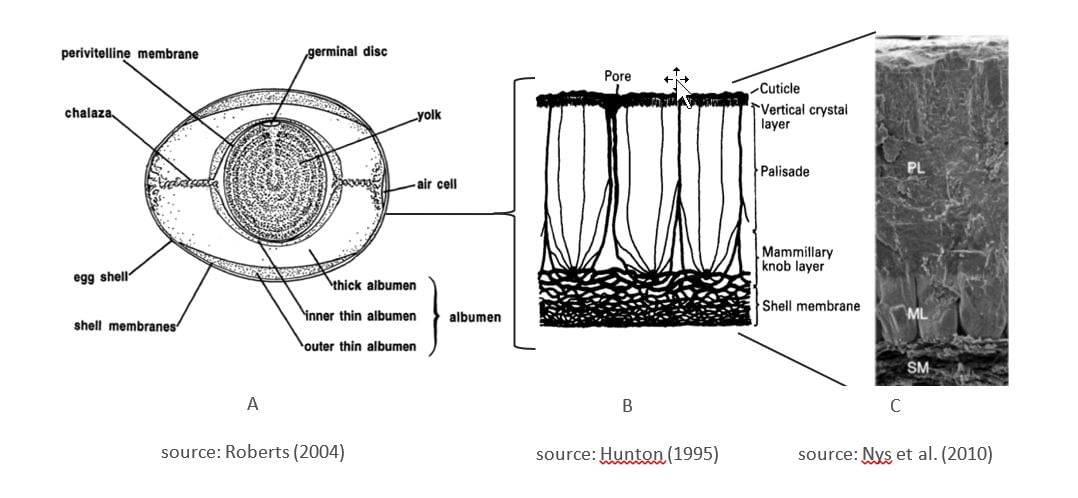 At that moment, air is sucked through the pores and the air chamber is formed (figure 4). The egg is very vulnerable at that moment. When there are bacteria on the egg, they are also sucked into the egg. Then you have a contaminated egg. This is especially problematic for hatching eggs, because bacteria inside the egg hinder the development of the embryo and decrease the hatchability of the embryo (van den Brand et al., 2016).
At that moment, air is sucked through the pores and the air chamber is formed (figure 4). The egg is very vulnerable at that moment. When there are bacteria on the egg, they are also sucked into the egg. Then you have a contaminated egg. This is especially problematic for hatching eggs, because bacteria inside the egg hinder the development of the embryo and decrease the hatchability of the embryo (van den Brand et al., 2016).
 Contamination of the egg can be caused by different factors. It could be that hen laid her egg outside of the nests provided, so-called floor and system eggs (Figure 5).
Contamination of the egg can be caused by different factors. It could be that hen laid her egg outside of the nests provided, so-called floor and system eggs (Figure 5).
 The egg could also get dirty if the egg is laid in the nest, but the nest or egg belt is not clean (Figure 6).
The egg could also get dirty if the egg is laid in the nest, but the nest or egg belt is not clean (Figure 6).
 In this case you can often see the print of a wet egg that roles over a nest mat. Besides contamination, the egg could also get damaged. This can be in the form of an open crack (Figure 7) or hairline cracks (Figure 8).
In this case you can often see the print of a wet egg that roles over a nest mat. Besides contamination, the egg could also get damaged. This can be in the form of an open crack (Figure 7) or hairline cracks (Figure 8).
 Damage can be caused the hens themselves, because they peck at the eggs or step on them. A suboptimal transportation of the egg can also cause damage. With a hairline crack, the shell is broken through the complete thickness, but the shell membrane is still intact. These cracks decrease the egg shell strength and devaluate the selling price of table eggs.
Damage can be caused the hens themselves, because they peck at the eggs or step on them. A suboptimal transportation of the egg can also cause damage. With a hairline crack, the shell is broken through the complete thickness, but the shell membrane is still intact. These cracks decrease the egg shell strength and devaluate the selling price of table eggs.
The cracks lead to an increased risk of bacterial contamination, which has a negative influence on food safety (consumption eggs) and a decrease of hatching performance (hatching eggs). Research shows us that in average hatching eggs with hairline cracks have 40% less hatchability (Barnett et al., 2004). The chicks hatched from hairline cracked egg are significant smaller at birth and show a 5% higher mortality at day 14.
Optimising the egg way
So frequently, the cause of a bad egg quality is caused by factors that arise after lay, during the “egg way”. The egg way is the way an egg travels. For layers is this the moment of lay until the eggs are on the table. For breeders is this from the moment of lay until the hatching of the chick. As Vencomatic Group, we continually try to optimise the egg way. We have knowledge of the complete egg way, have high quality equipment to optimise the egg way and offer management support by the poultry specialists. This helps producers to maximise their profit by maximising first grade eggs and minimise dirty and damaged eggs. There are a lot of transitions in the egg way that can be a potential risk on egg quality.
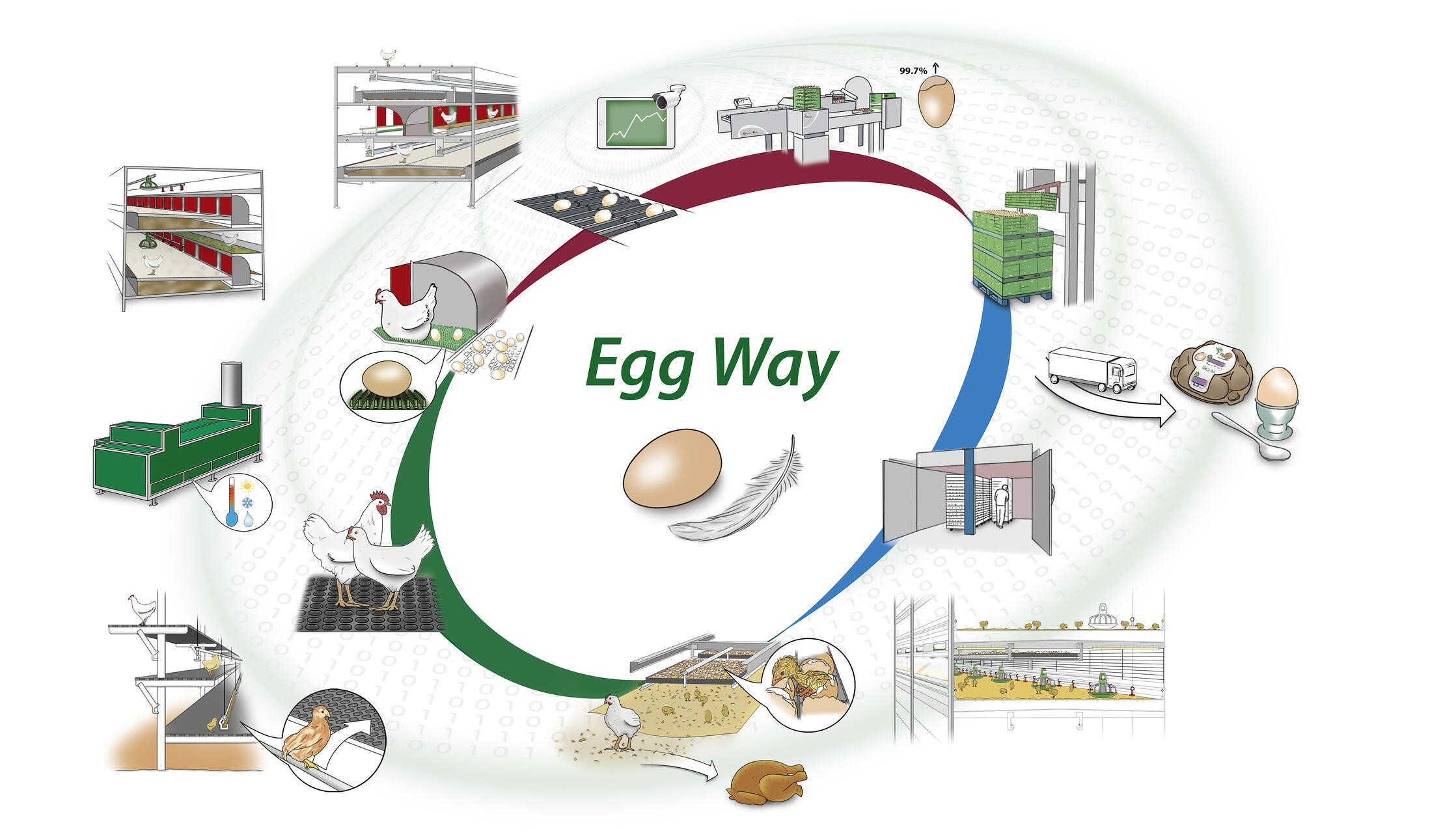
The egg way starts with a good quality and clean nest. Make sure the contact with nesting material is a minimum as possible. The nests need to be clean and the eggs must roll smoothly, but direct to the egg belt. Of course it is important to have as many eggs as possible in the nest, so floor eggs should be prevented from the start of the egg production. When the egg is out of the nest, the contact point with the egg belt should be minimised.
Check frequently if the egg belts are clean, so it doesn’t leave marks on the eggs. Transitions are a risk, so make sure eggs run smoothly over each transition without encountering any sharp edges. Frequent egg collection is advised, because too many eggs on the egg belt increase the risk of eggs bumping against each other. Also make sure the speed of your transportation belts are adjusted to one another.
Vencomatic Group developed a tool to measure all these transitions and to make sure all is running optimal, the Gregg. The Gregg is a kind of robot egg and each egg is full of sensors. When the Gregg rolls over an transition, it registers the g-forces. In the end the transition gets a mark, so adjustments can be made based on data instead by eye.
We also have a range of products that automate processes usually done by the farmer, that have an effect on egg quality. The so-called Meggsius products range from a leaking egg detector to an egg counting system that adjusts transportation belt speeds and an automatic egg grader. All these tools and products help the farmer to improve their egg quality.
Finally the eggs are ready to put in trays, different types of trays exist for stage and transportation. It is important is that fresh air can come between the eggs and that the temperature of the eggs does not become too high.
Paper trays have the advantage that they are hygienic, because they are only used once. However, they are easily compressed and with high humidity the eggs get stuck in the tray. Plastic trays are stronger and you can stack them easy, but sometimes sharp edges cause cracks. Eggs must not be in contact with each other and sit firmly in the tray.
Hatching eggs have to be positioned point down. This is important for the embryonic development and during hatch chicks first pick inside the air cell (Schulte-Drüggelte, 2011). Finally, storage condition and time also impact the egg quality. Storing consumption eggs for longer periods and/or at higher temperatures makes them less fresh for the consumer. It causes eggs to lose weight, increases the air cell size and alters the egg composition (Akyurek & Okur, 2009). Storing hatching eggs for longer periods reduces chick quality and the growth of the chicks (Tona et al., 2003).
Overall we can conclude that many factors determine egg quality. Positive is that we have many aspects in own hands for the perfect egg.
With thanks to Anne van den Oever for editing.












.png?width=160&height=132&name=Egg%20packers%20-%20Vencomatic%20Group%20(2).png)
.png?width=160&height=132&name=Meggsius%20Select%20-%20Vencomatic%20Group%20(2).png)





